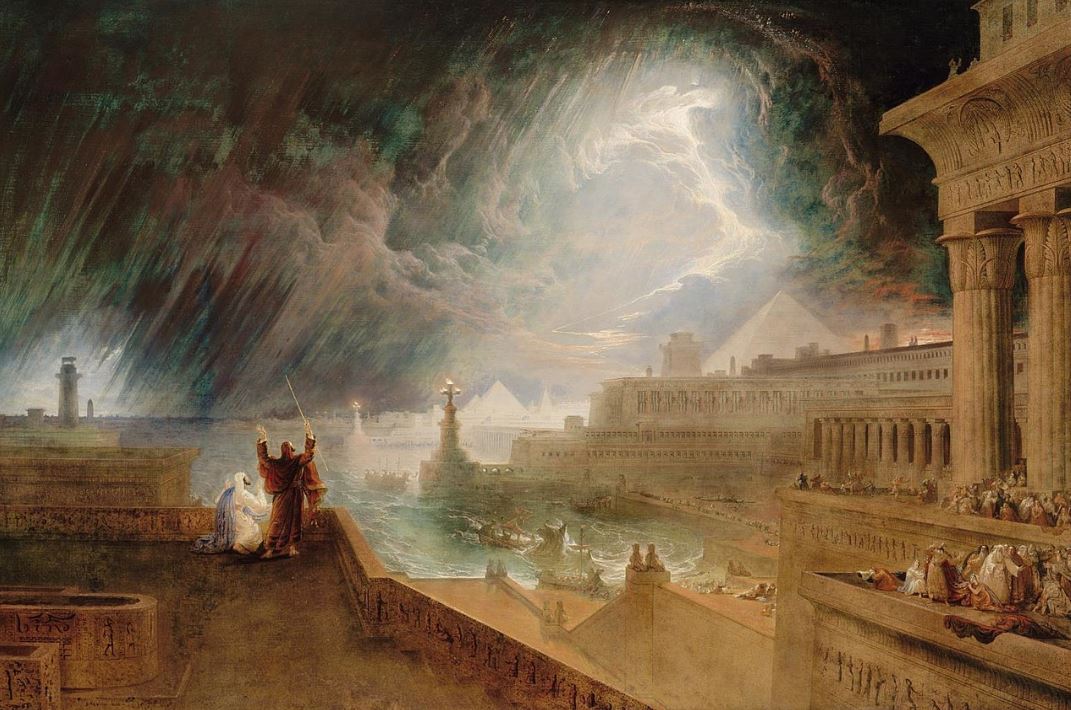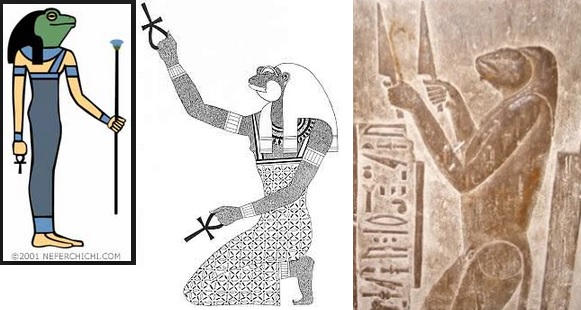Next Tuesday is the seventeenth of Tamuz, commemorating a handful of tragedies in Jewish history starting with the shattering of the Tablets following the sin of the Golden Calf. A careful examination of Torah chronology reveals that there may be one more major event that took place at this time, and it involves the Ten Plagues in Egypt. While the Torah describes in great detail how the Ten Plagues came about, it says very little about their timing. All we know is that the final plague upon the firstborn was on the fifteenth of Nisan. Can we work backwards from this point and create an exact timeline of when the Ten Plagues occurred?
The Mishnah (Eduyot 2:10) states that the judgement upon the Egyptians prior to the Exodus took place over a span of 12 months. Moshe arrived in Egypt from Midian around the fifteenth of Nisan, and led his people out of Egypt on that same date one year later. We are given a major timing clue in Exodus 7:25, which states that the first plague of blood lasted one full week. Rashi (Rabbi Shlomo Itzchaki, 1040-1105) comments here that the Torah is actually providing us with a general rule: all the plagues lasted a week, just as the first one did. Each plague was followed by a three-week respite (and warnings) before the next plague. That means the Ten Plagues took place over ten months. With this in mind, we can reconstruct the entire timeline and make sense of why certain plagues occurred specifically when they did.
Our starting point is the only date given in the Torah: the fifteenth of Nisan. This is when the final plague upon the firstborn began. One might ask: how could each plague last a week if we know all the deaths of the firstborn took place over the course of that one night? One possible answer is that the Egyptians may well have observed a nation-wide mourning period, a shiva of seven days. Thus, even the final plague resulted in a full week of misery and suffering! At the end of their shiva, the officers arose from their mourning to pursue the Israelites once more, and catch them at the Red Sea. (Recall that the Splitting of the Sea took place on the seventh day following the Exodus.)
Working backwards, the ninth plague of darkness would have begun around the fifteenth of Adar. The Torah states that the darkness lasted three days. Intriguingly, centuries later this would be the time of Purim. To avert the dark decree of Haman, Esther had instituted a three-day fast. Haman’s evil plans crumbled, and “For the Jews was light and joy…” (Esther 8:16) Again, we have to say that although the thick darkness lasted three days, the entire terror spanned seven (it must have taken time to transition out of the darkness and restore normalcy). It is worth noting that according to tradition, Moses was born in Adar. Baby Moses glowed at birth, prompting his mother Yocheved to say that he is entirely tov, “good” and wholesome (Exodus 2:2). He would later glow again, so much brighter that he had to wear a mask (Exodus 34:29-35). It is therefore interesting to parallel the glowing light of Moses with the abject darkness of the ninth plague—both of which came in Adar.
A month earlier, around the fifteenth of Shevat came the plague of locusts. The Torah tells us that the locust was specifically directed to “eat all your trees that grow out of the field.” (Exodus 10:5) This is most appropriate, since the fifteenth of Shevat is the “New Year for Trees”! Similarly, the seventh plague of hail came around the fifteenth of Tevet, fittingly in the heart of winter. Egypt generally has no precipitation, even in winter, so the hail must have come as a great surprise. It served as further confirmation that Hashem is in charge of climate, and all natural cycles are under His control.

‘The Seventh Plague’ by John Martin (1823)
The month of Chanukah, Kislev, brought the plague of boils. This is appropriate, too, since the Greek descendants of Yefet (literally “beauty”) prioritized external appearance, vanity, and nakedness. (“Gymnasium” literally means a place to be naked, and athletes in the ancient Greek Olympics competed in the nude!) Egyptians had a similar preoccupation with the external, and were early pioneers in things like cosmetics and bodily ornaments. The boils were precisely an attack upon the skin of the Egyptians and their outer appearance.
Cheshvan, typically the start of the flu season, brought pestilence. This pestilence primarily affected the Egyptians’ livestock. It wiped out all the animals much like, centuries earlier, the Great Flood did in Cheshvan at the time of Noah (who saved only two of each to avoid their extinction). Next, we have the fourth plague—the mixed stampede of ‘arov—which would have landed around the fifteenth of Tishrei. This week of animal invasion mirrors the week that the Israelites would later celebrate Sukkot. Perfectly, a sukkah is literally a simple “animal hut” (while an ohel is a human one).
Before that, on the fifteenth of Elul came the great plague of lice. This one was so significant that the Egyptian magicians gave up and admitted: “It is the finger of God!” (Exodus 8:15) Henceforth, they no longer tried to mimic the plagues. This is a critical moment, and we can deduce that by this point, Pharaoh lost the support of his cabinet and was left alone. In fact, the Talmud (Rosh Hashanah 11a) points out that it was specifically on Rosh Hashanah, ie. the first of Tishrei, that the slavery for the Israelites stopped. So, the plague of lice was experienced between the fifteenth and twenty-first of Elul, after which the Egyptian soothsayers threw in the towel, the fearful taskmasters abandoned their posts, and just days later on the first of Tishrei the Israelite servitude was officially lifted.
A month earlier, on the fifteenth of Av, came the plague of frogs. The frog was a symbol of fertility in ancient Egypt, and the Egyptian idol of fertility was frog-headed. God punished the Egyptian idolaters measure-for-measure with super abundant and extra fertile frogs. Beautifully, this same date later became the Jewish holiday of Tu b’Av, a day of matchmaking and marriages, love and fertility. (The Arizal sees within the word for “frog”, tzfarde’a [צפרדע], the root de’a [דע], meaning “knowledge” and being the Biblical term for intimate union between husband and wife. Note also that the name of the month, Av, is literally a parent.)

Heket, the ancient Egyptian frog-headed goddess of fertility
Finally, we get to the first plague, blood, which would have begun around the fifteenth of Tamuz. This, too, is precise because the Nile River actually reaches its shallowest point in June, and then begins to rise again in July. Just as the Egyptians were awaiting the water levels to be restored and bless their land, they instead got a surging river of blood. It is here that we come back to the start of our discussion:
The plague of blood took place between the fifteenth and twenty-first of Tamuz, and just one year later this would be a tragic week in which a group of wicked people constructed a Golden Calf (on the sixteenth) before Moses returned and smashed the Tablets (on the seventeenth), followed by a brief civil war and a plague upon the Israelites (Exodus 32:35). God had earlier warned them that if the people heed God’s voice, and “do what is upright in God’s sight, giving ear to God’s commandments and keeping all God’s laws, then I will not bring upon you any of the plagues that I brought upon the Egyptians, for I am YHWH, your healer.” (Exodus 15:26) The people failed, so exactly a year after God had brought the first plague upon the Egyptians, He brought a plague upon the Israelites—just as He warned he would.
So, we have yet another significant thing to commemorate and mourn on the Seventeenth of Tamuz. We should not lose sight of the fact that, as a people, we ultimately bring suffering upon ourselves. We should never forget that it is God who is our Healer. I am reminded of the accurate words of Isaac Newton who said: “Trials are medicines which our gracious and wise Physician gives because we need them; and the proportions, the frequency, and weight of them, to what the case requires. Let us trust His skill and thank Him for the prescription.”
Now, what about those first two months of Moses in Egypt? What happened before the plagues began in Tamuz? Moses arrived in the middle of Nisan. He first met his brother and convened with the Israelite elders. He showed them the three signs that God had previously given him at their initial encounter on Sinai (Exodus 4). It would have surely taken some time for word to spread that the Redeemer had arrived, both among the Israelites and among the Egyptians. It is therefore reasonable to suggest that Moses and Aaron first came before Pharaoh about a month later, in the middle of Iyar. The result of this encounter was that the Israelite slavery actually got worse, and the people experienced the most difficult period of their oppression (Exodus 5). Indeed, Iyar is considered a month of Gevurah and Din, the bulk of Sefirat haOmer, and the period in which our Sages state the wicked in Gehinnom are most harshly judged. (This is found in that same Mishnah, Eduyot 2:10, from which we learn that the pre-Exodus sequence lasted one year).
The following month, in Sivan, Moses and Aaron appeared before Pharaoh the second time, and now revealed that they come as representatives of God Almighty (Exodus 7). It is here that they first start working their miracles, and turned the staff into a serpent. This initial divine revelation mirrors the much grander Revelation at Mount Sinai one year later at the same time. Again, the parallels in timing are striking! A month later in Tamuz came the first plague of blood, completing the entire sequence of events. To summarize:
Nisan 2447: Moses returns to Egypt.
Iyar: Moses and Aaron first appear before Pharaoh, following which servitude worsens.
Sivan [6?]: Moses and Aaron appear before Pharaoh a second time, first revelation of God, duel of the serpent-staffs.
Tamuz 15-21: Plague #1 – Blood
Av 15-21: Plague #2 – Frogs
Elul 15-21: Plague #3 – Lice
Tishrei 1, 2448: Servitude Ends
Tishrei 15-21: Plague #4 – Animals
Cheshvan 15-21: Plague #5 – Pestilence
Kislev 15-21: Plague #6 – Boils
Tevet 15-21: Plague #7 – Hail
Shevat 15-21: Plague #8 – Locust
Adar 7: Birthday of Moses
Adar 15-21: Plague #9 – Darkness
Nissan 15: Plague #10 – Firstborn, the first Pesach, followed by Exodus
Nissan 21: Splitting of the Sea
Sivan 6: Sinai Revelation
Tamuz 16: Golden Calf
Tamuz 17: Moses returns and smashes the Tablets
Tamuz 19: Moses goes back up Sinai for the second forty-day period
Av 29: Moses returns from Sinai
Elul 1: Moses ascends Sinai for the third and final forty-day period
Tishrei 10, 2449: Moses returns, God forgives the Israelites, establishing Yom Kippur
